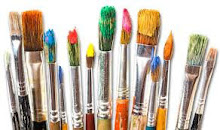Real paint, real things and a strategy

I needed a break from working with computers so I decided to take up painting.
I wanted to do real paintings with real paints.
I was only interested in learning representational painting.
I soon found that creating a real representational painting requires a daunting host of skills.
Minor rant about tutorials feel free to ignore
Looking for help, I watched a lot of painting tutorials on YouTube. Some good, some not. They seemed to be made by people who either trotted out rules without much insight:
Get the shadow colour by adding its complementary colour.
You mustn't use black.
To get a good, vivid octarine1 you should always mix raw hooloovoo2 with a little burnt amaklor-kalish3.
Some of these guys are trying too hard to look good and come across as an expert. They disguise their mistakes and hide the areas with which they struggle even though those would be the most interesting and useful bits.
Or worse, people with tremendous natural talent who just knew exactly what to do but who could not see that there was magic in there that needed to be explained:
What we want here is a nice warm green, *splat*slap*daub*, just like that.
There are no rules. Paint whatever you want, however you want.

draw the rest of the owl
That's a bit:
draw the rest of the owl
.
draw the rest of the owlphenomenon even has its own subreddit
I will do my best not to fall into these traps.
So, I decided to cheat. I would automate as many of the requirements as possible. I could then pick from them and focus on a single skill, one at a time.
and then learning to ride a unicycle,
and then learning to juggle whilst riding a unicycle.
This also meant that my initial attempts at painting produced decent outcomes which encouraged me to keep moving forward.
paint without fear.
I needed to come up with a learning strategy because that is the kind of geek I am.
The first key to good drawing and painting is good observation.
We cannot depict a golden retriever if we have never seen one before another minor rant, please ignore me
Even if we have seen lots of them can we really remember their proportions and colours well enough? Do we know what separates them from other dogs?
Even when we have an individual in mind and we know her well but we are not currently looking at her, do we really know her distinctive characteristics by heart?

Even if we can remember her proportions, colours and characteristics, can we envisage how she would look mid leap? The enthusiasm in her eyes? Can we envisage her lit by a low early morning sun?
Does it matter?
drawing of a dogand drawing Buttercup.
So that lead me to the first part of the strategy:
*** Always paint from some sort of reference. ***
So, key number 2:
*** Paint from digital reference images. ***
This immediately helps to solve many difficulties in one go.
put the right colours in the right places. A photograph can tell us both what and where.
Ok, but why digital reference images?
No comments:
Post a Comment
Talk to me